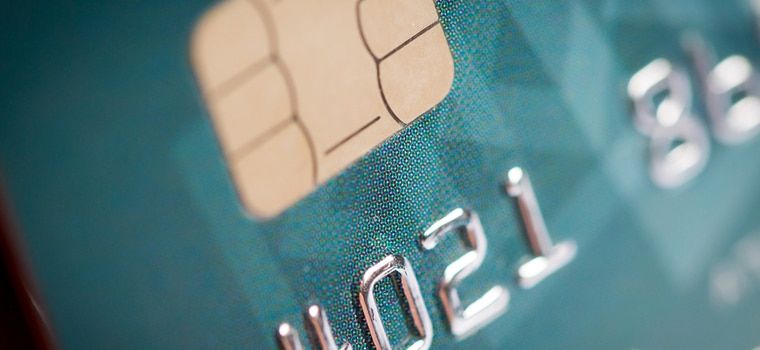An EMV chip is the small, square chip that you may have seen on your credit and debit cards. It adds extra layers of protection to your card to keep your information secure. EMV stands for Europay, Mastercard and Visa, the three companies responsible for developing the standard.
The EMV chip is designed to protect against fraudulent activity, and it appears to be working. Since the introduction of the EMV chip in October 2015 until March 2019, merchants with EMV chip-enabled terminals experienced a 76% decline in point-of-sale (POS), counterfeit payment fraud.
How Do EMV Cards Work?
EMV cards work like magnetic stripe cards do, only instead of sliding your card through the card reader, you insert it into a terminal slot. Making a purchase is the same as swiping the card in that you need to provide your PIN number to verify your identity. However, the chip adds protections to the transaction to make it safer.
You may hear EMV cards referred to by many names, such as the following:
- Chip-and-Signature Cards
- Chip-and-PIN cards Chip-and-Choice Cards
- Smart Cards
- EMV Smart Cards
- Smart Chip Cards
- Smart Payment Cards
- Chip-and-Choice Cards
- Chip Cards
- IC (“Integrated Circuit”) Cards
When you use an EMV-enabled terminal, the chip in your card and the terminal exchange information to create an encrypted code, which is called a token or a “cryptogram”. In basic terms, this encrypted code ensures that the only person or organization that reads the transaction data is the financial institution or network associated with the card. The token is dynamic, meaning it’s unique to the transaction in progress, and will only be used at that one particular time.
Once your unique token is generated, it must be decoded to make sure it is from your card’s chip. To do so, the token is either sent to your card issuer over the internet or it can be verified within the terminal. These two methods are known as online verification and offline verification respectively.
The purchase is approved after the system successfully verifies the token and the available credit on your card. When the transaction is complete, that code number is essentially useless. Even if someone was able to copy the number, he or she wouldn’t be able to make any purchases with the card.
Are EMV Cards More Secure Than Traditional Swipe Cards?
Yes, EMV cards are more secure than swipe debit and credit cards because they employ a unique encryption code for each transaction. This dynamic code differs from the static information stored in a credit card’s magnetic stripe, which remains the same for all transactions and is able to be copied.
EMV chips can still be hacked but it requires more sophisticated and expensive equipment than a simple card skimmer as thieves often do to steal information from your card’s magnetic stripe. A skimmer is a small, hard-to-detect device a thief places over the card swipe mechanism on ATMs, gas station pump terminals, and other credit card readers.
When a consumer swipes the card through a skimmer, the device accesses and saves the details stored in the magnetic stripe of the card. Thieves then have the credit or debit card holder’s full name, card number and expiration date allowing them to make fraudulent charges online or with a counterfeit card.
EMV chip data, however, can’t be read simply by inserting the card into a reader. The chip is a sophisticated microprocessor that can’t be scanned, copied, and replicated
Although cards still have the swipe stripe on the back, use the chip instead whenever possible, as it is the more secure payment method. If your chip-card is not accepted, the terminal will indicate an error and tell you to swipe.
EMV chips only work when they are used, and not all retailers have switched over to EMV enabled payment terminals. That means you still have to swipe your card at some businesses.
This is especially true with gas stations, which aren’t mandated to enable terminals until October 2020. Gas stations have been a preferred site for thieves because it’s easier to install credit card skimmers.
Can I Use My Chip Card Everywhere?
Yes, you can use your EMV chip debit or credit cards anywhere. You can only use the chip’s functionality if the merchant has a chip-enabled terminal available. Otherwise, you can still swipe your card’s magnetic stripe through the reader. All EMV cards being issued still have magnetic stripes so consumer spending is not disrupted.
You can still complete the transaction, although you’ll lose the extra layer of chip security. Thankfully, retail participation with EMV cards is on the rise with 61% of U.S. brick and mortar stores and 89% of U.S ATM locations now accepting these cards.
The Bottom Line
The EMV, while not entirely impenetrable for hackers, is a significant security upgrade over the traditional magnetic stripe. EMV cards are easy to use and can make card transactions more secure.
Just remember the EMV chips only help shield against in-person fraud. Always check your account statements to look for fraudulent activity.
EMV chips can help you protect your credit card information but there are other ways identity thieves are targeting consumers. Learn the different types of identity theft to safeguard your information now.




